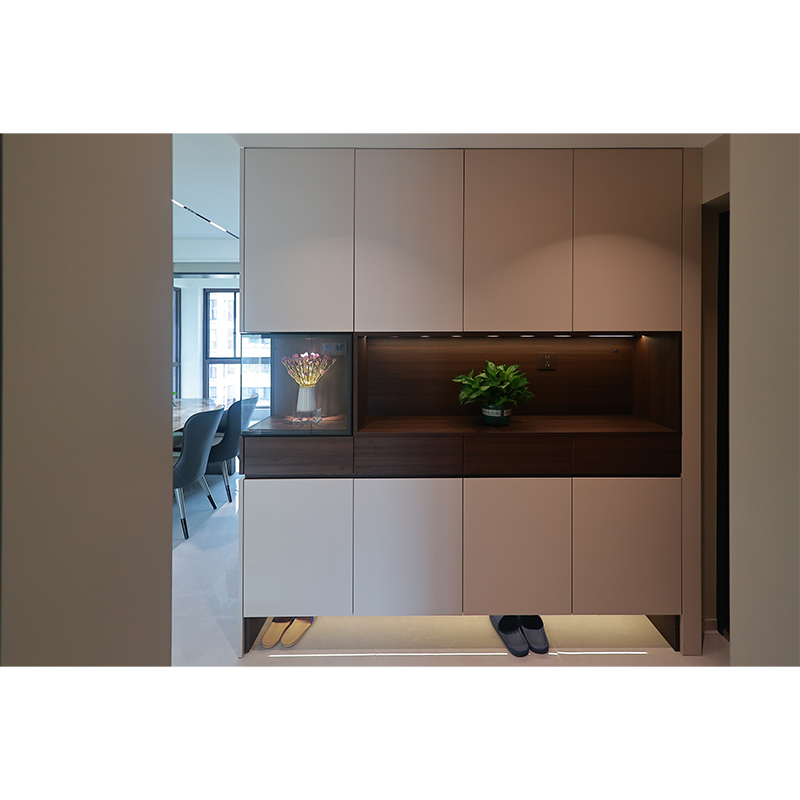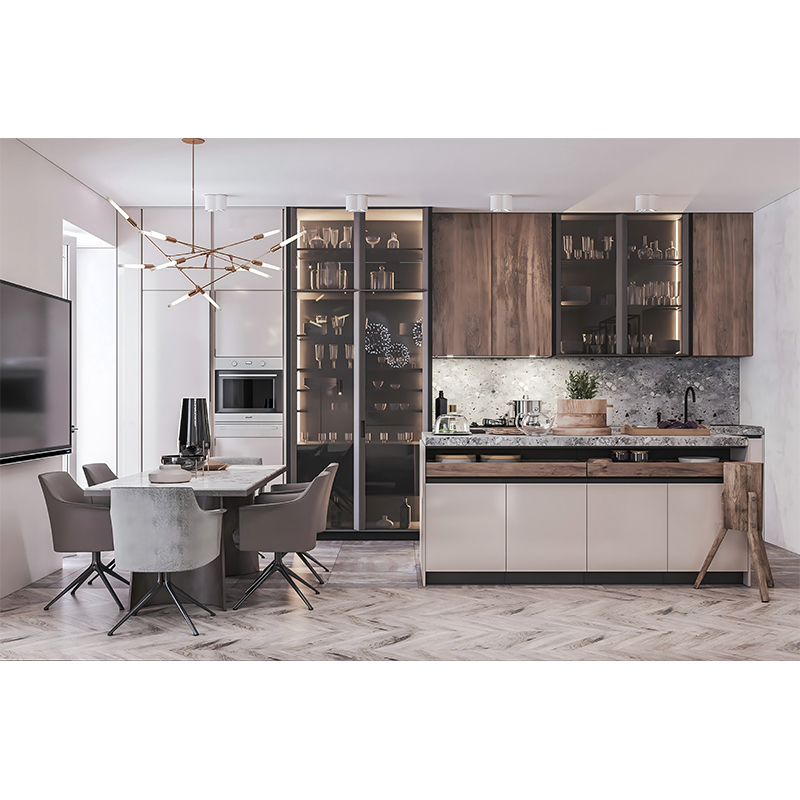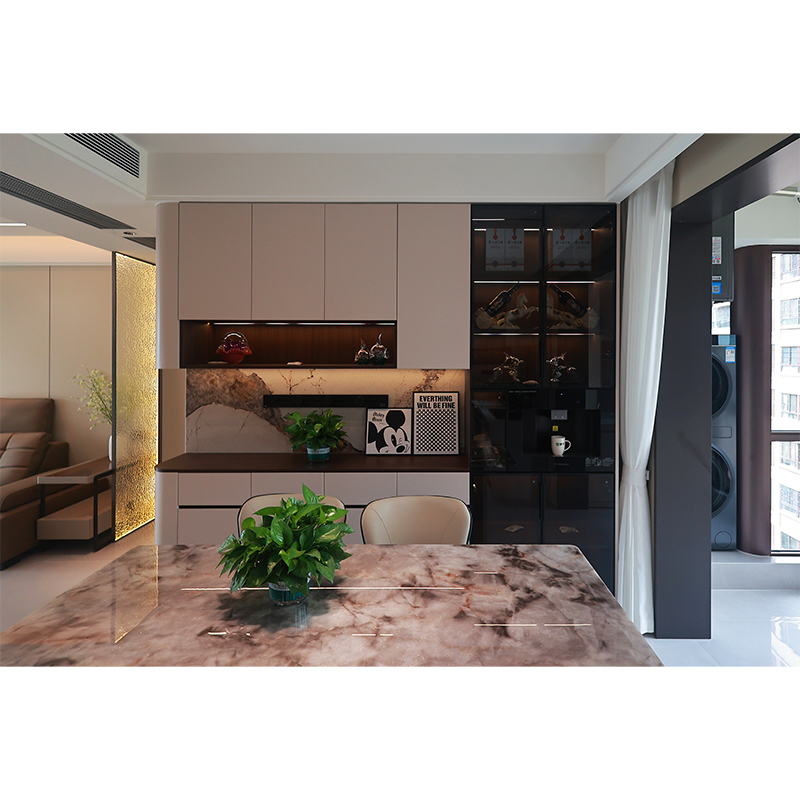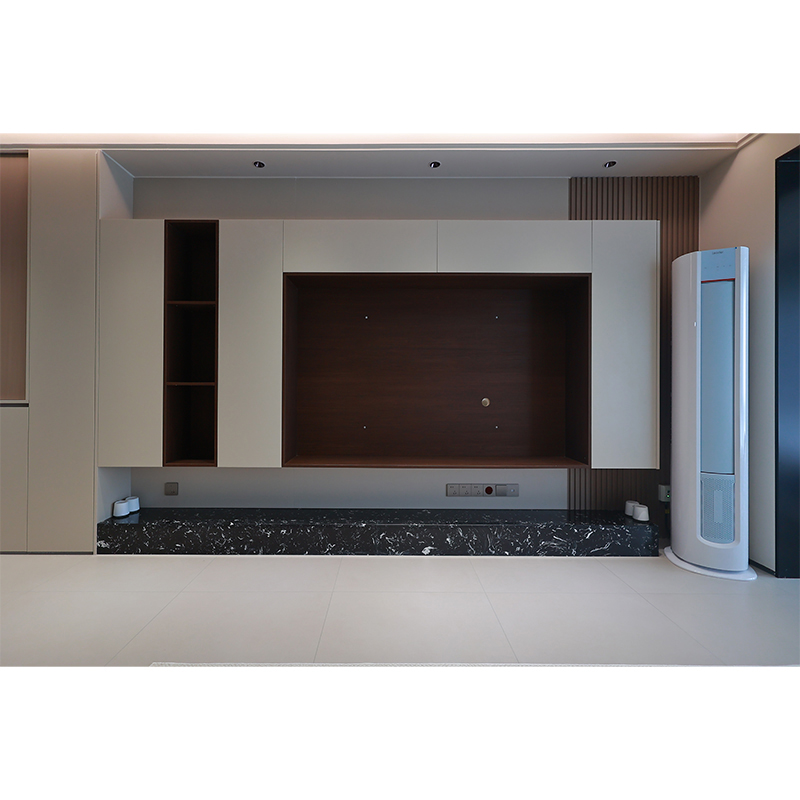How can custom TV cabinets be precisely designed based on wall dimensions and spatial structure?
Release Time : 2025-08-27
The core value of custom TV cabinets lies in "tailoring"—it's not about shoehorning furniture into a space, but rather allowing it to grow from it. The length, height, and flatness of each wall, every corner, every pipe, every door and window position, all contribute to a unique spatial language. The design process of a custom TV cabinet is a profound interpretation and response to this language. It transcends the limitations of standardized production. Through precise measurements and personalized design, the cabinet seamlessly integrates with the wall, floor, and ceiling, achieving a perfect balance of function and aesthetics.
The first step in precise design begins with a comprehensive space survey. Designers or surveyors must record the actual wall dimensions on-site, rather than relying on theoretical data from architectural drawings. Walls may have subtle tilts, bumps, or corner variations. Ignoring these details can result in noticeable gaps between the cabinet and the wall, or even a poor fit. Laser distance measurement and a level are used to ensure the accuracy of length, width, and height data. The opening range of doors and windows, the location of switches and sockets, the routing of air conditioning ducts, and the locations of power and signal ports required on the TV back panel are also noted. This information forms the basis for the custom design.
Based on this data, the design must respond to the structural characteristics of the space. For non-standard apartment layouts, such as spaces with curved or angled walls or columns, the TV cabinet can be cut in a special shape or assembled in sections to align the cabinet's contours with the wall's direction, avoiding harsh straight lines that disrupt the flow of the space. If there are protruding pipes or distribution boxes on the wall, the cabinet can be designed with a partially recessed or enclosed structure to cleverly conceal the obstruction and transform it into a functional area. For spaces with large ceilings, a floor-to-ceiling design not only enhances the visual extension but also maximizes vertical space, creating a complete storage and display system.
The location of the TV itself is the central anchor of the design. The cabinet's structure must be adapted to the TV's installation method—wall-mounted or stand-mounted. If the TV is wall-mounted, allow ample clearance above the cabinet to avoid obstructing the screen. Consider the depth of the TV base or bracket to ensure overall harmony. Pre-buried cable holes or concealed cable ducts should be installed in the back of the cabinet to allow power cables, HDMI cables, audio cables, and more to pass through neatly and converge in the equipment storage area, creating a neat and tidy "hidden lines within form." For ports requiring maintenance, removable back panels or removable covers can be designed to balance aesthetics and practicality.
Functional layout should be tailored to user habits. Frequently used audio equipment, game consoles, and set-top boxes should be placed in open compartments or glass cabinets with doors to facilitate heat dissipation and remote control signal transmission. Books, collectibles, or decorative items can be placed in visually focused areas with prominent lighting. Less frequently used items should be stored in closed cabinets or drawers to maintain a clear visual experience. Drawer slides and door hinges should be precisely positioned to ensure they do not interfere with the wall, furniture, or human movement when opened.
The choice of materials and colors also contributes to the integration of the space. The cabinet's surface texture and color can complement the floor, sofa, or wall paint, creating a unified visual tone. Wood veneers add warmth, lacquered panels enhance a modern sheen, and metal accents add luxurious details. Through the contrast and interplay of materials, the TV cabinet becomes more than an isolated piece of furniture, but rather an integral part of the spatial narrative.
Finally, the design is presented in 3D renderings to help users anticipate the actual effect. The factory performs precision machining based on the drawings, ensuring that every panel and every hole position meets on-site requirements. During installation, a professional team conducts on-site commissioning, fine-tuning levels and gaps to ensure the cabinet fits securely and securely, almost as if it were embedded.
The precision of a custom TV cabinet goes beyond dimensional accuracy; it also reflects a deep understanding of lifestyle, the spatial ambiance, and the details of its intended use. It allows the furniture to disappear into the space while remaining fully present through its functionality, truly achieving the design realm of "the invisible surpasses the visible."
The first step in precise design begins with a comprehensive space survey. Designers or surveyors must record the actual wall dimensions on-site, rather than relying on theoretical data from architectural drawings. Walls may have subtle tilts, bumps, or corner variations. Ignoring these details can result in noticeable gaps between the cabinet and the wall, or even a poor fit. Laser distance measurement and a level are used to ensure the accuracy of length, width, and height data. The opening range of doors and windows, the location of switches and sockets, the routing of air conditioning ducts, and the locations of power and signal ports required on the TV back panel are also noted. This information forms the basis for the custom design.
Based on this data, the design must respond to the structural characteristics of the space. For non-standard apartment layouts, such as spaces with curved or angled walls or columns, the TV cabinet can be cut in a special shape or assembled in sections to align the cabinet's contours with the wall's direction, avoiding harsh straight lines that disrupt the flow of the space. If there are protruding pipes or distribution boxes on the wall, the cabinet can be designed with a partially recessed or enclosed structure to cleverly conceal the obstruction and transform it into a functional area. For spaces with large ceilings, a floor-to-ceiling design not only enhances the visual extension but also maximizes vertical space, creating a complete storage and display system.
The location of the TV itself is the central anchor of the design. The cabinet's structure must be adapted to the TV's installation method—wall-mounted or stand-mounted. If the TV is wall-mounted, allow ample clearance above the cabinet to avoid obstructing the screen. Consider the depth of the TV base or bracket to ensure overall harmony. Pre-buried cable holes or concealed cable ducts should be installed in the back of the cabinet to allow power cables, HDMI cables, audio cables, and more to pass through neatly and converge in the equipment storage area, creating a neat and tidy "hidden lines within form." For ports requiring maintenance, removable back panels or removable covers can be designed to balance aesthetics and practicality.
Functional layout should be tailored to user habits. Frequently used audio equipment, game consoles, and set-top boxes should be placed in open compartments or glass cabinets with doors to facilitate heat dissipation and remote control signal transmission. Books, collectibles, or decorative items can be placed in visually focused areas with prominent lighting. Less frequently used items should be stored in closed cabinets or drawers to maintain a clear visual experience. Drawer slides and door hinges should be precisely positioned to ensure they do not interfere with the wall, furniture, or human movement when opened.
The choice of materials and colors also contributes to the integration of the space. The cabinet's surface texture and color can complement the floor, sofa, or wall paint, creating a unified visual tone. Wood veneers add warmth, lacquered panels enhance a modern sheen, and metal accents add luxurious details. Through the contrast and interplay of materials, the TV cabinet becomes more than an isolated piece of furniture, but rather an integral part of the spatial narrative.
Finally, the design is presented in 3D renderings to help users anticipate the actual effect. The factory performs precision machining based on the drawings, ensuring that every panel and every hole position meets on-site requirements. During installation, a professional team conducts on-site commissioning, fine-tuning levels and gaps to ensure the cabinet fits securely and securely, almost as if it were embedded.
The precision of a custom TV cabinet goes beyond dimensional accuracy; it also reflects a deep understanding of lifestyle, the spatial ambiance, and the details of its intended use. It allows the furniture to disappear into the space while remaining fully present through its functionality, truly achieving the design realm of "the invisible surpasses the visible."







